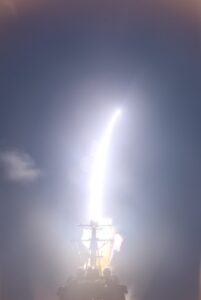The unclassified version of the newest Missile Defense Review (MDR) released Thursday adds a new emphasis on homeland cruise missile defense, counter-unmanned aircraft systems (C-UAS), and defense of Guam.
The Defense Department released the unclassified version of the MDR nested within the unclassified version of the 2022 National Defense Strategy (NDS).
While the document restates the overall focus on traditional ballistic missile defense, particularly geared against North Korea, the Biden administration’s new document talks up a missile defeat approach beyond just “rogue state” nuclear missile threats.

“Missile defeat encompasses the range of activities to counter the development, acquisition, proliferation, potential and actual use of adversary offensive missiles of all types, and to limit damage from such use…. as part of this comprehensive approach, the United States will also continue to improve defensive capabilities to address the threat of evolving cruise missile strikes by any adversary against the homeland,” the MDR said.
The MDR fact sheet, released alongside the overall NDS, argued “emerging ballistic, cruise, hypersonic, and lower-tier threats such as uncrewed aircraft systems (UAS) pose an expanding and accelerating risk to the U.S. homeland, U.S. forces abroad, and our allies and partners.”
The MDR implied non-nuclear cruise missile defense of the homeland is also meant to defend against Chinese and Russian capabilities in a potential conflict.
“To deter attempts by adversaries to stay under the nuclear threshold and achieve strategic results with conventional capabilities, the United States will examine active and passive defense measures to decrease the risk from any cruise missile strike against critical assets, regardless of origin.”
The fact sheet highlighted Russia’s “indiscriminate use of thousands of cruise missile attacks in Ukraine” demonstrates that “developing missile defenses against cruise missiles is increasingly vital.”
The Defense Department also mentioned how developing new sensor technology is useful for homeland cruise missile defense.
“Modern over-the-horizon radar capabilities are essential to improving warning and tracking against cruise missile and other threats to the homeland,” the MDR said.
On Thursday, Tom Karako, Director of the Center for Strategic and International Studies (CSIS) Missile Defense Project, underscored the MDR’s discussion of air defense and cruise missile defense is one of the larger changes in this iteration of the document.
“You see an explicit embrace within the paradigm of missile defense for cruise missile defense, specifically of the homeland. In fact there’s quite a bit of attention to the new emphasis on homeland missile defense, although not for the rogue state ICBMs but for, frankly, conventional cruise missile type of attack,” Karako told reporters Thursday during a phone call following the document release.

“The document today talks about, frankly, the need to stop a non-nuclear strategic attack on the homeland. Not just Guam, not just Hawaii, but also here in [the Continental United States], for the 80 percent or so of conventional forces that we keep here at any given time,” he continued.
Karako also pointed out a “pretty significant emphasis on counter-UAS. This was not in the last missile defense review of 2019. Good to see it here.”
“One area of importance related to [Integrated Air and Missile Defense] is the increasing challenge of counter-UAS (C-UAS). UAS are an inexpensive, flexible and plausibly deniable way for adversaries endeavoring to carry out tactical-level attacks below the threshold for major response, making them an increasingly preferred capability for state and non-state actors alike,” the document said.
The MDR warned UASs can have similar lethality to cruise missiles and be launched from many types of locations undetected, but are “generally not perceived by adversaries as having the same destabilizing geostrategic implications as larger missile forces, making them an increasingly preferred method to carry out tactical-level strikes.”
Therefore, MDR said both the U.S. homeland and forward deployed forces require fielding “technical and integrated C-UAS solutions with cross-DoD and interagency synchronization to ensure they can meet the range of threats and appropriately hedge against future advancements. Within the homeland, protecting the population from UAS threats is a combined interagency mission.”
Separately, the review also highlighted the importance of defending the U.S. territory of Guam as part of homeland defense.
“Within the context of homeland defense, an attack on Guam or any other U.S. territory by any adversary will be considered a direct attack on the United States, and will be met with an appropriate response. Additionally, Guam is home to key regional power projection platforms and logistical nodes, and is an essential operating base for U.S. efforts to maintain a free and open Indo-Pacific region.”
Karako said these efforts to defend Guam “in some respects ought to be the poster child for the Biden administration’s missile defense approach.”
“Just on the budget documents we’ve seen so far, this is about four-plus billion dollars for the defense of Guam. The missile defense review today notes Guam has a unique position: it’s both U.S. territory, it is U.S. homeland, unequivocally they say; but it’s also emphatically very much a regional base for power projection. So, especially that latter point that, frankly, is why you’re seeing the emphasis on it. We can’t afford to not defend it because we have to project power,” he added.
The MDR said the missile defense architecture of Guam will “be commensurate with its unique status as both an unequivocal part of the United States as well as a vital regional location. Guam’s defense, which will include various active and passive missile defense capabilities, will contribute to the overall integrity of integrated deterrence and bolster U.S. operational strategy in the Indo-Pacific region.
The MDA seeks $539 million in the FY ‘23 defense budget request to continue designing, developing and procuring components for Guam defense (Defense Daily, April 1).
In March, MDA announced the Guam missile defense architecture will include the Lockheed Martin [LMT] Aegis combat system, Raytheon Technologies [RTX] Standard Missile (SM)-3 and SM-6 missiles, and the Northrop Grumman [NOC] Integrated Air and Missile Defense Battle Command System (IBCS) with a Terminal High Altitude Area Defense battery previously deployed to Guam will remain as well (Defense Daily, March 29).